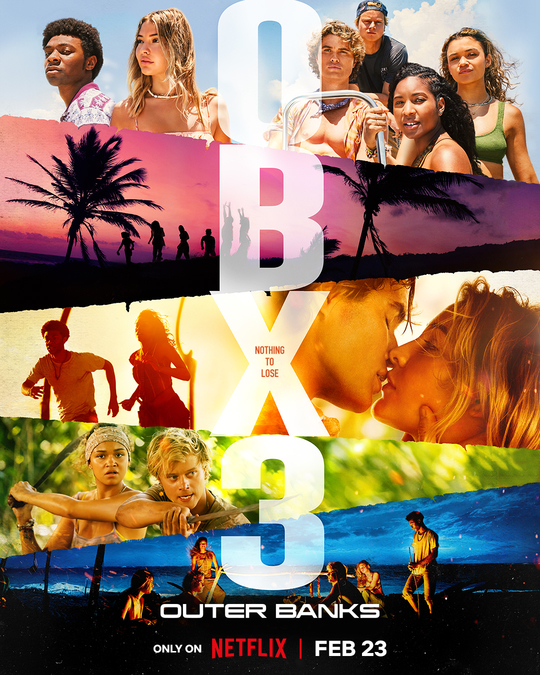Spoiler Warning: Outer Banks seasons 1 and 2, but not season 3.
Outer Banks, the Netflix coming-of-age treasure hunting series whose first two seasons enjoyed massive viewership on the back of a sometimes-cheesy, often-delightful, always-charming script and a strong ensemble cast, is back for a third season. The Chicago Maroon spoke with Outer Banks (OBX) stars Chase Stokes (John B) and Rudy Pankow (JJ) about the future of the hit show and the challenges of maintaining OBX’s relatability amid an increasingly chaotic plot.
The first season of OBX spent most of its time in the titular Outer Banks of North Carolina, where the Pogues (working class teenagers John B, JJ, and Pope, plus their friends Kiara and Sarah) both argued and and physically fought with the islands’ kooks, (wealthy resident teens Kelce, Topper, and Sarah’s brother Rafe). By the second season, the show’s scope has sprawled to include the Caribbean, in Charleston, on a cargo ship—and the cast of characters includes an additional Pogue (Cleo), more formidable villains, and John B’s long-lost father, Big John. The show isn’t quite as confusing as that description makes it sound, but it’s definitely not the kind of show one should start watching from the third season.
Where season 2 struggled at times to stay focused, season 3 is smart to return for a substantial period to North Carolina. This decision is especially important because, by this point, any semblance of a realistic plot has been lost. The teenagers have moved on from searching for a sunken ship to way bigger treasure: they’re up against a Caribbean mob, and they’ve gotten disturbingly good at disarming enemies. Season 3 of OBX is like Pirates of the Caribbean, Indiana Jones, James Bond, and Scooby Doo all rolled into one.
“Where some projects fail with action and adventure is that they lose sight of character,” Stokes told The Maroon. No matter how big the plot and explosions in OBX get, he remarked, every scene keeps a keen eye on personalities, grounding a show whose mood has drifted further and further away from the first season’s easy-going disposition. Stokes is right in his assertion—This season,with full-fledged characters, older actors, and darker themes, is a more mature version of the young-adult-oriented show. Responsibility and fear of responsibility are, to Pankow, the two biggest themes of the new season.
This more thoughtful OBX deals deftly with the return of John B’s father: heroes, Outer Banks wants to say, are not always all they’re made out to be. It’s easy to be overly romantic about people in one’s past.
Unfortunately, other themes are left underexplored. Is young love naive? The show does not really say, and too often feels like it does not really care. There’s almost no exploration of the contrast between life on the Outer Banks and on the protagonists’ island paradise, Poguelandia. And while the motivations of Sarah’s father—season 1 villain Ward Cameron—are developed further, season 3 villain Carlos Singh is given very little discernible motive. Singh is pure evil and comically so—there’s almost no nuance to be found.
Outer Banks has never been, and continues not to be, a show one watches for the nuance; it is filmed largely in dramatic close-ups, intercut with shaky-cam action, and seems to contain at least one long flashback scene and a couple of etiolated monologues per episode. The dialogue and the cinematography tend toward the repetitive and could stand to be a touch more evocative; however, this season does benefit greatly from less hit-you-over-the-head-obvious conversations between the Pogues (compared to the first two seasons), some genuinely stunning landscape wide shots, and an entertaining soundtrack.
Without spoiling the plot, let’s just say this season makes some curious choices with regards to character arcs. John B, Big John, Rafe, Ward, and Sarah all make serious, narrative-altering decisions for insufficiently persuasive reasons. A fine cast—Pankow as JJ and Charles Esten as Ward in particular— are on the verge of having their characters betrayed by the script, only to be rescued by the season’s final two episodes. In the big picture, OBX’s characters generally end the season in the right place—dramatically and logically—even if it seems for several episodes that such will not be the case.
And, gracefully, the season finale dispelled this critic’s biggest fear: that Outer Banks’ excitement could only be sustained through constant cliffhangers and unresolved plot points. This is an ending which, if not perfectly, at least satisfyingly brings three rollercoaster seasons to a close. “When I read [season 3’s] conclusion, my brain started turning, because there’s so many ways that this can go. In that sense, I think it’s the best [ending] out of the three,” remarked Stokes. Outer Banks was renewed for a fourth season on February 18th, so John B and the rest of the Pogues are here to stay, even if this season ends somewhere the series could reasonably have concluded.
“I think John B is just a kid struggling to find consistency in his life and hoping that he finds it,” Stokes told The Maroon when asked about his character’s motivations. Outer Banks—in season 3—may have just found its own essential, if unconventional, consistency.
Outer Banks season 3 premieres on Netflix on February 23rd.









